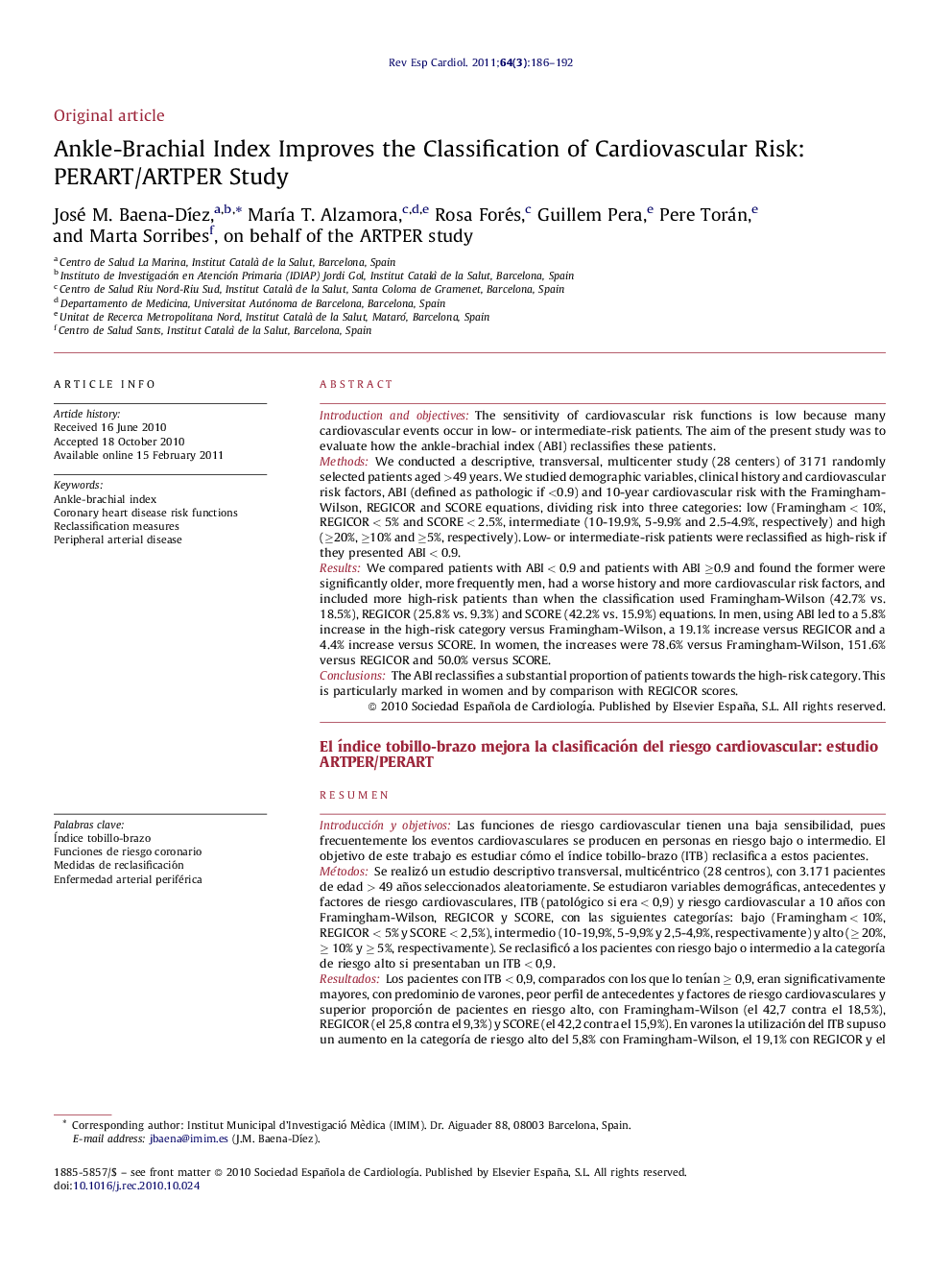| Article ID | Journal | Published Year | Pages | File Type |
|---|---|---|---|---|
| 3018327 | Revista Española de Cardiología (English Edition) | 2011 | 7 Pages |
Introduction and objectivesThe sensitivity of cardiovascular risk functions is low because many cardiovascular events occur in low- or intermediate-risk patients. The aim of the present study was to evaluate how the ankle-brachial index (ABI) reclassifies these patients.MethodsWe conducted a descriptive, transversal, multicenter study (28 centers) of 3171 randomly selected patients aged >49 years. We studied demographic variables, clinical history and cardiovascular risk factors, ABI (defined as pathologic if <0.9) and 10-year cardiovascular risk with the Framingham-Wilson, REGICOR and SCORE equations, dividing risk into three categories: low (Framingham < 10%, REGICOR < 5% and SCORE < 2.5%, intermediate (10-19.9%, 5-9.9% and 2.5-4.9%, respectively) and high (≥20%, ≥10% and ≥5%, respectively). Low- or intermediate-risk patients were reclassified as high-risk if they presented ABI < 0.9.ResultsWe compared patients with ABI < 0.9 and patients with ABI ≥0.9 and found the former were significantly older, more frequently men, had a worse history and more cardiovascular risk factors, and included more high-risk patients than when the classification used Framingham-Wilson (42.7% vs. 18.5%), REGICOR (25.8% vs. 9.3%) and SCORE (42.2% vs. 15.9%) equations. In men, using ABI led to a 5.8% increase in the high-risk category versus Framingham-Wilson, a 19.1% increase versus REGICOR and a 4.4% increase versus SCORE. In women, the increases were 78.6% versus Framingham-Wilson, 151.6% versus REGICOR and 50.0% versus SCORE.ConclusionsThe ABI reclassifies a substantial proportion of patients towards the high-risk category. This is particularly marked in women and by comparison with REGICOR scores.
ResumenIntroducción y objetivosLas funciones de riesgo cardiovascular tienen una baja sensibilidad, pues frecuentemente los eventos cardiovasculares se producen en personas en riesgo bajo o intermedio. El objetivo de este trabajo es estudiar cómo el índice tobillo-brazo (ITB) reclasifica a estos pacientes.MétodosSe realizó un estudio descriptivo transversal, multicéntrico (28 centros), con 3.171 pacientes de edad > 49 años seleccionados aleatoriamente. Se estudiaron variables demográficas, antecedentes y factores de riesgo cardiovasculares, ITB (patológico si era < 0,9) y riesgo cardiovascular a 10 años con Framingham-Wilson, REGICOR y SCORE, con las siguientes categorías: bajo (Framingham < 10%, REGICOR < 5% y SCORE < 2,5%), intermedio (10-19,9%, 5-9,9% y 2,5-4,9%, respectivamente) y alto (≥ 20%, ≥ 10% y ≥ 5%, respectivamente). Se reclasificó a los pacientes con riesgo bajo o intermedio a la categoría de riesgo alto si presentaban un ITB < 0,9.ResultadosLos pacientes con ITB < 0,9, comparados con los que lo tenían ≥ 0,9, eran significativamente mayores, con predominio de varones, peor perfil de antecedentes y factores de riesgo cardiovasculares y superior proporción de pacientes en riesgo alto, con Framingham-Wilson (el 42,7 contra el 18,5%), REGICOR (el 25,8 contra el 9,3%) y SCORE (el 42,2 contra el 15,9%). En varones la utilización del ITB supuso un aumento en la categoría de riesgo alto del 5,8% con Framingham-Wilson, el 19,1% con REGICOR y el 4,4% con SCORE. En mujeres fue del 78,6% con Framingham-Wilson, el 151,6% con REGICOR y el 50% con SCORE.ConclusionesEl ITB reclasifica a una importante proporción de personas hacia la categoría de riesgo alto, sobre todo en mujeres y con la función REGICOR.
